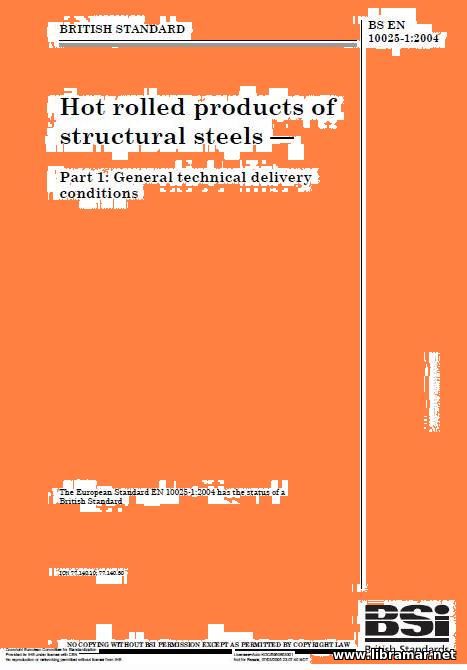 The present BS standard consists of six major parts. The first part is somewhat introductory and it addresses the general technical conditions of delivery; such conditions would normally be applicable to all steels - scope/normative references/terms & definitions/classification & designation/info to be supplied by the buyer/manufacturing process/requirements/ inspection/preparation of samples/test methods/marking, labelling and packaging/complaints/options/evaluation of conformity, while the other parts of the document deal with the TDC for non-alloy steels, normalized rolled and thermomechanical weldable fine grain structural steels, plus steels having improved characteristics of the atmospheric corrosion resistance, and flat products rolled from high yield strength steels in the tempered/quenched condition.
In general, this standard was released to specify the requirements for long and flat rolled structural steel products; however, it does not cover tubes and hollow sections. In addition, it is not applicable to steel products intended for general structural applications, and to coated products. The steels dealt with in the present document are to be used in welded/bolted/riveted structures.
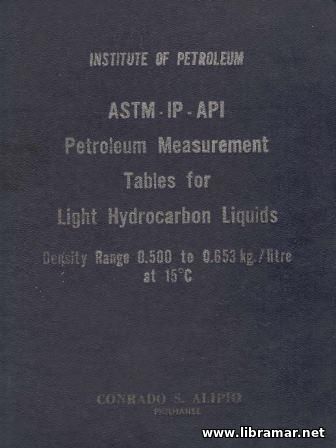 The full title of the present publication which was officially released by the Petroleum Institute is the ASTM-IP-API Petroleum Measurement Tables for Light hydrocarbon Liquids, density range 0.5000 to 0.653 kg/liter and taken at the 15 degrees Celsius temperature.
The tables contained in the book provide, in addition to the regular data, also the correction factor addressing the temperature change from observed to standard condition, as well as the formal procedures established for the implementation of the computers. It shall be noted that the subject procedures had never been published before.
Prior to proceeding to the tables, it is recommended to go through the introductory part of the volume, giving necessary information about the basis of these tables, and the characteristics involved. The appendix A deals with the calculation of the tabulated values utilizing the computers, while the appendix B provides references.
Needless to say that the content of this volume will be of practical use to every person dealing with these petroleum products on the regular basis, when performing their working duties, and shall be readily available for reference at all times.
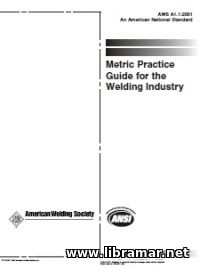 The content of the present practice guide bases on the SI system and includes the basic and derived units together with the rules for their use and conversion factors. The recommendations contained in the pages of this official publications have been presented in a clear way and supplemented with the suggestions to the welding industry for better management of the transition. The main volume is divided into seven basic parts.
The first part defines the scope of the document while the second part provides general information about the SI system including its main advantages, uniqueness, coherence and completeness. The remaining parts cover the units and symbols of the system, style and usage, systems units commonly pertaining to the welding industry, conversions, preferred numbers, their application and value of using them, and transition including main considerations.
Numerous annexes to the book supplement it and provide additional information considered nonmandatory. The publication will be of practical interest to all people involved in the welding industry and any associated works to be performed in compliance with the recognized international standards.
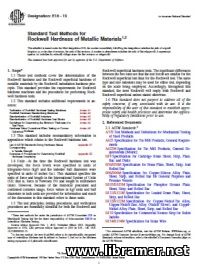 The official ASTM publication devoted to the standard test methods used for determining the Rockwell hardness of metals. The test methods covered in the document address the determination of the Rockwell hardness/superficial hardness of metals using the principles of indentation hardness. The publication was released to provide necessary requirements for the hardness testing machines as well as the procedures established for performing such testing.
Some additional information has been included in the annexes to the main part of the standard - they are dealing with the verification of the testing machines, standardizing machines, standardization of the indenters and hardness test blocks, correction of the hardness values obtained during the testing of the convex cylindrical surfaces; finally, the provide guidelines on how to determine the minimum thickness of the test pieces.
Some of the non-mandatory technical information such as the examples of the procedures to determine the uncertainty of the Rockwell hardness of the metallic materials has also been provided for easy reference. The volume will be useful for the people dealing with the mechanical properties of metallic construction materials.
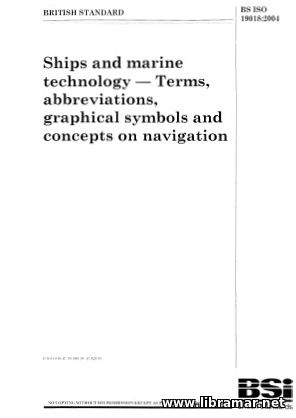 This is the official release of the BS ISO 19018-04 standard. The publication is divided into several chapters. The first one defines the scope of the document, the following ones address related normative references and special units applicable to the maritime navigation; the others are as below - Course, heading, track and speed; Bearings; Corrections; Influence of currents and winds; Geographical coordinates, positions, lines, graphical symbols; Waypoint navigation; Terms of time; Astronomical navigation; Depth of water and tides; Terrestrial magnetism; Radar navigation; LORAN-C; Global Positioning System.
This team of authors and editors who prepared on this standard, made their best trying to include the maximum possible number of important and relevant abbreviations, maritime terms and graphical systems - they are all frequently used in marine navigation on board vessels. It shall be noted, however, that the abbreviations listed in this paper should not actually be used in math formulae; the symbols that are allowed to be used in formulae are mentioned. The navigation itself if the process of finding the exact position of the ship; it also includes the planning, recording and controlling of how the vessel is moving from one position to another.
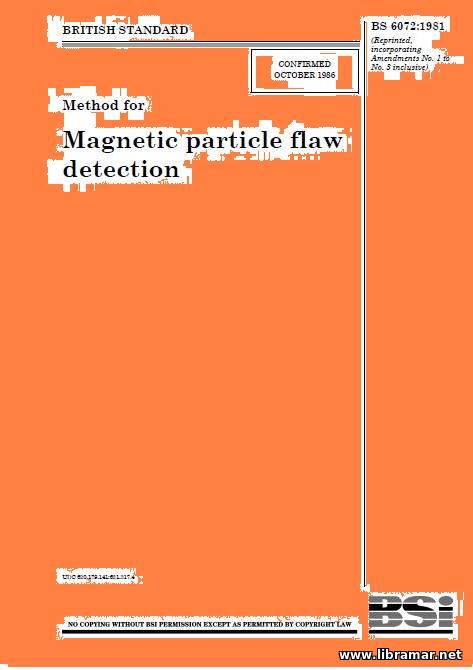 The classic British Standard related to one of the most reliable and popular methods of nondestructive evaluation. The chapters making this document introduce the reader to the magnetic particle flaw detection, define the scope and provide the references and basic definitions, address the equipment used during the inspection, detecting media, all associated procedures (preparation, magnetization, current flow/threading bar or cable/rigid coil techniques, flexible cable technique, magnetic flow, induced current flow techniques, viewing and recording of indications, proper reporting, demagnetization and, finally, cleaning.
The Appendixes at the end of the publication provide some necessary supplementary data. In fact, the application of this method of nondestructive evaluation has already been described within several BS standards over the past years and it was considered necessary to prepare a separate basic standard that would address this particular method. And this is how the present BS 6072 standard has been developed and subsequently released - it provides people with a very detailed info on this method; however, we have to mention that some slight variation in the regular technique might be required for a number of particular applications.
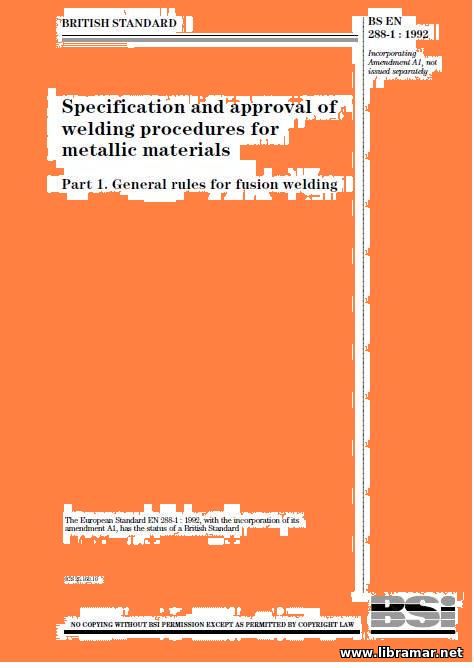 The WPS referred to in the present British Standard, are required in order to provide a well defined basis for planning of any construction operations that would include welding, as well as for quality control during welding, evaluation of the established weld seams, assessment of the welding connections etc.
Welding itself is considered a very special process in the terminology of quality system standards - such standards would usually imply that special processes are to be carried out in full accordance with the written WPS, i.e. welding procedure specifications. Any possible deviations, as well as distortions and other imperfections, can be evaluated by means of the various nondestructive testing (NDT) methods on the newly established weld seam.
The special problem is constituted by the metallurgical deviations, because today's level of NDT technology does not allow for the nondestructive evaluation of the mechanical properties - this necessitated the establishment of a completely new set of applicable rules for approval of the WPS prior to the its release to actual production. There are nine parts in this standard, covering the general rules applicable to fusion welding, welding of the aluminum and aluminum alloys, WPS for arc welding, various welding procedure tests applicable approval of the standard WPS, pipeline welding, offshore applications etc.
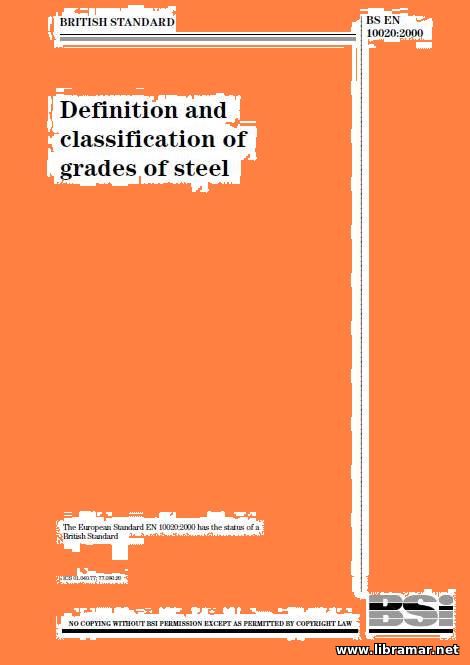 Quite clear, this British Standard deals with the classification and definition of steel grades. It was prepared by Technical Committee ECISS/TC6 and replaces the standard EN 10020:1988 which is now considered obsolete. The document consists of the four chapters - scope - term and definition - classification by chemical composition - classification of main quality classes.
The first two parts provide some standard definitions that are in use by BS EN. The part dealing with the chemical composition tells readers about the alloy contents, definition of alloy classes, stainless and non-alloy steels, as well as of the other alloy steels. The last part describes the non-alloy quality and special steels, stainless steels, other alloy steels and allow quality and special steels from the classification viewpoint. The table in the booklet describes boundary between alloy and non-alloy steels (specified elements vs limit values).
Another table is dedicated to the weldable fine grained alloy steels. The standard takes into account all latest developments in the iron and steel industry as well as recent progress in EU standardization so will definitely be useful and practical.
|







